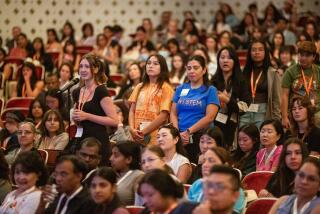Turning Point : Windmill Project Puts Dyslexic Student in State Science Contest
- Share via
Steve Goldberg trails off in confusion when he tries to spell the name of the high school he attends. When asked to read a phone number offa sheet of paper, he falters, then hands the paper to a friend.
But dyslexia has not dampened the 16-year-old’s appetite for learning. Although letters and numbers shift and cross before his eyes, mechanical problems appear clearly in his mind.
On May 25, Steve will compete in the state high school science fair after taking the top prize out of about 500 contenders at the Los Angeles County Science Fair. Organizers of the contest said Steve’s project--a wind tunnel and turbine he devised to test his design for a highly efficient windmill blade--is on a par with work done by professional engineers.
Steve, a student at the private Chaminade College Preparatory School in West Hills, is one of an estimated 5% of California schoolchildren found to have learning disabilities; of those, 1% to 2% are dyslexic.
Dyslexia, thought to be caused by a neurological disorder, interferes with reading ability. Symptoms vary, but many dyslexics tend to reverse or skip letters and numbers while reading, said Michael Spagna, assistant professor of special education at Cal State Northridge.
Steve, an amiable youth with a wide grin, entered school at a time when a variety of learning strategies and computer software were available to help dyslexic students not only to cope but, in some cases, to succeed in surprising ways, Spagna said.
Because he mixes up the letters A, B, C and D, Steve’s teachers often give him oral tests instead of written ones. And he still wrestles with an inability to read aloud. Occasionally, dyslexia complicates his life in frustrating ways, such as the time he lost count of his laps at a swim meet and stopped in the middle of his race.
Despite these difficulties, in many ways Steve is a model high school student, so much so that his parents have wondered if his impairment might have worked to his advantage.
“Dyslexia forces you to concentrate extremely hard to straighten things out,” said Steve’s father, Gerry Goldberg, an electrical engineer. “Many people never learn extreme concentration . . . but Steven becomes very intense in certain circumstances.”
Steve agrees that a knack for intense concentration, and a willingness to put in hours of monotonous work, helped him to put together a complex and highly technical science project.
For several years, he has devoted countless after-school hours in his father’s workshop, studying models of windmills, a machine that has enthralled him since his parents first took him to Tehachapi Pass, where scores of windmills line the hillsides.
“I wanted to know why they turned,” Steve said. “I know it sounds like a crock, but I actually do it because I want to learn.”
For the science fair project, Steve devised a test to measure the effect of placing small bits of metal, or “tipplets,” at an angle on each blade of a model windmill.
“I was examining the effect of off-angle winds on horizontal-axis wind turbines,” he said.
Windmills work best when their blades are perpendicular to the wind, he explained. When a windmill is placed on a hillside, it is usually less efficient because the wind hits the blades at an angle. The tipplets can compensate for the effect, increasing the turbines efficiency by 5% to 10%, he found.
“It’s a remarkable level of achievement for high school,” said Arie Korporaal, science consultant for the Los Angeles County office of education, sponsor of the fair.
Margery Weitkamp, Steve’s science teacher at Chaminade, has taught other dyslexic students who, like Steve, excelled in mechanics and engineering. Such subjects may suit dyslexics because they require hands-on rather than book learning, Weitkamp said.
“They don’t all necessarily have high grade-point averages, but they are brilliant in the areas they are good at,” she said.
Steve said his view of his dyslexia has changed as his ability to compensate has improved.
“I laugh at it. If I don’t, I will be a hairball of stress,” he said.
More to Read
Sign up for Essential California
The most important California stories and recommendations in your inbox every morning.
You may occasionally receive promotional content from the Los Angeles Times.










